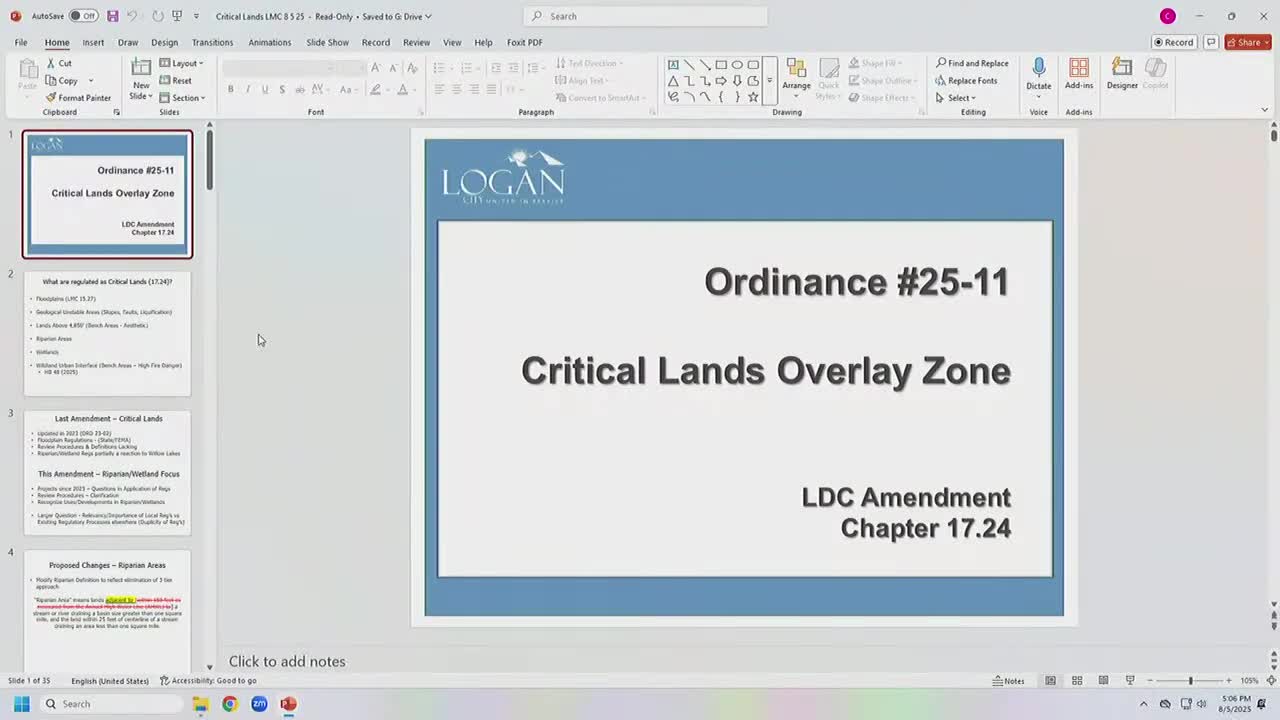Logan City Council Proposes Critical Lands Code Amendments for Environmental Protection
August 06, 2025 | Logan City Council, Logan, Cache County, Utah
This article was created by AI summarizing key points discussed. AI makes mistakes, so for full details and context, please refer to the video of the full meeting. Please report any errors so we can fix them. Report an error »

Logan City officials are gearing up for significant changes to the land development code, particularly concerning the management of critical lands, including floodplains and wetlands. During the Logan Municipal Council meeting on August 5, 2025, council members discussed amendments aimed at streamlining regulations and addressing the challenges posed by existing land use.
The proposed changes focus on the critical lands overlay zone, which encompasses areas prone to flooding, geological instability, and other environmental concerns. A key highlight of the discussion was the need to adapt local regulations in response to recent updates from FEMA regarding floodplain management. Council members acknowledged that the current regulations were outdated and often duplicated existing state and federal guidelines.
One of the most notable amendments includes a reduction of the riparian area setback from 100 feet to 25 feet. This change is intended to accommodate the realities of Logan's already developed landscape, where enforcing larger setbacks could be impractical and unfair to property owners. Council members emphasized the importance of balancing environmental protection with the need for housing development, especially in a city that is largely built out.
Additionally, the council proposed clarifying regulations surrounding wetlands, including establishing a 25-foot buffer zone instead of the current 50 feet. This adjustment aims to facilitate development while still protecting vital ecological areas. The council also discussed the importance of allowing parks and recreational facilities within these buffers, recognizing their value to the community.
The meeting underscored the city's commitment to revising its land use policies to better reflect current environmental standards and community needs. As these amendments move forward, city officials anticipate further discussions and mapping efforts to ensure compliance with state mandates by the end of the year. The proposed changes are expected to foster a more practical approach to land development while safeguarding Logan's natural resources.
The proposed changes focus on the critical lands overlay zone, which encompasses areas prone to flooding, geological instability, and other environmental concerns. A key highlight of the discussion was the need to adapt local regulations in response to recent updates from FEMA regarding floodplain management. Council members acknowledged that the current regulations were outdated and often duplicated existing state and federal guidelines.
One of the most notable amendments includes a reduction of the riparian area setback from 100 feet to 25 feet. This change is intended to accommodate the realities of Logan's already developed landscape, where enforcing larger setbacks could be impractical and unfair to property owners. Council members emphasized the importance of balancing environmental protection with the need for housing development, especially in a city that is largely built out.
Additionally, the council proposed clarifying regulations surrounding wetlands, including establishing a 25-foot buffer zone instead of the current 50 feet. This adjustment aims to facilitate development while still protecting vital ecological areas. The council also discussed the importance of allowing parks and recreational facilities within these buffers, recognizing their value to the community.
The meeting underscored the city's commitment to revising its land use policies to better reflect current environmental standards and community needs. As these amendments move forward, city officials anticipate further discussions and mapping efforts to ensure compliance with state mandates by the end of the year. The proposed changes are expected to foster a more practical approach to land development while safeguarding Logan's natural resources.
View full meeting
This article is based on a recent meeting—watch the full video and explore the complete transcript for deeper insights into the discussion.
View full meeting

